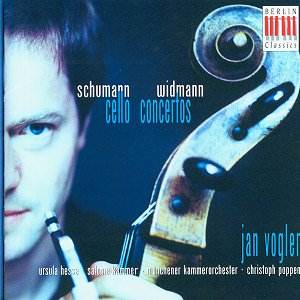Though the principal aim of the present release is
to demonstrate Jan Voglerís multifaceted talent, the main attraction
of it is Jörg Widmannís cello concerto Dunkle Saiten.
Jörg Widmann trained as a clarinet player, and
has been quite active as performing artist. (He gave the first performance
of Wolfgang Rihmís Musik für Klarinette und Orchester "Linien
II" written for him.) He also studied composition with
Kay Westermann, Hans Werner Henze, Wilfried Hiller and Wolfgang Rihm.
His cello concerto Dunkle Saiten ("Dark
Strings"), completed in 2000 and dedicated to Jan Vogler, is undoubtedly
a considerable achievement and, quite likely (for I know nothing else
of his music), one of his most ambitious works so far. It is a single
movement design playing for three quarters of an hour, falling into
four sections, roughly cast in an arch form. The first section, predominantly
slow, emerges from the depths of the orchestra and unfolds in a song-like
manner. A dark-hued, sorrowful chant building up towards an impressive
climax. In the second section, the celloís song becomes more urgent,
supported by sharper orchestral textures and insistent rhythms, sometimes
unrelated to the celloís seemingly endless song. A mighty crescendo
leads into the third section which is somewhat more varied and contrasted,
and alternates orchestral interjections and sighs from the cello. The
music gets some momentum, and becomes tenser and more agitated as it
progresses. The celloís song reaches the instrumentís highest register.
The celloís shrieks are echoed by the two soprano voices that introduce
the fourth and final section. The voices, as it were, mix with the celloís
high tones and later have some cadenza-like passages in which
they have to produce some curious, ululating, nasal sounds, noises temporarily
almost silencing the cello itself a voice that has been present from
the very first bar of the piece. The cello re-enters for the dreamy,
ethereal conclusion. This large-scale work is most certainly an impressive,
deeply felt, personal statement, though I am not quite convinced by
the final section, and particularly by the inclusion of voices in the
orchestral fabric. I feel that they could have been deployed to magnify
the powerfully lyrical character of the concerto; instead they tend
to disrupt the flow rather than enhancing it. This is, I think, the
only miscalculation on the composerís part in what is otherwise a gripping,
communicative work of great emotional power and, one that often explores
material of great beauty.
As far as I can judge, Voglerís reading of Schumannís
Cello Concerto in A minor is very fine, though I must
confess that I have never been a fan of this work. Needless to say:
I would have preferred to have another work by Widmann who is, I believe,
a most distinguished composer.
Excellent performances and recordings. Recommended
for Widmannís concerto. In spite of my reservations this is a splendid
work well worth investigating.
Hubert Culot


